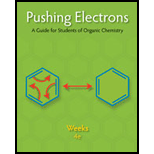
Concept explainers
Hydrogen is a Group I element and each hydrogen will contribute I valence electron. Carbon is a Group (Roman numeral) element and each carbon will contribute ___ (number) electrons. Every oxygen atom in a compound will contribute valence electrons.
Chloromethane has the molecular formula
and the number of valence electrons may be determined as follows. There are three hydrogen atoms, each of which contributes 1 valence electron; the single carbon contributes 4 electrons; and the single chlorine atom contributes 7 electrons, making a total of 14. A convenient tabular form of this calculation is
Interpretation:
The group number and the valance electrons in the given elements C and O are to be identified.
Concept Introduction:
In an atom, the electrons revolve around the nucleus in orbits/shells.
The shells are numbered/named from the side of nucleus. The last shell from the side of nucleus is called as ultimate shell or valance shell.
Answer to Problem 1EQ
Carbon is a Group IV element and each carbon will contribute 4 electrons. Every oxygen atom in a compound will contribute 6 valence electrons.
Explanation of Solution
The of electrons present in the last shell (valance shell) are called as valance electrons. The number of valance electrons is equal to group number.
As Carbon is group IV element, it has 4 electrons in the last shell.
In the same manner, Oxygen belongs to group VI and has 6 electrons in the last shell.
The number of electrons present in the last shell of an atom are considered as valance electrons and they can be identified by group number of the element.
Want to see more full solutions like this?
Chapter 1 Solutions
Pushing Electrons
- Explain how to use the periodic table to determine that there are two chloride ions for every magnesium ion in magnesium chloride and one chloride ion for every sodium ion in sodium chloride. Then write the formulas for calcium oxide and potassium oxide and explain how you got them.arrow_forwardWould you expect each of the following atoms to gain or lose electrons when forming ions? What ion is the most likely in each case? a. Ra b. In c. P d. Te e. Br f. Rbarrow_forwardComplete the following table to predict whether the given atom will gain or lose electrons in forming the ion most likely to form when in ionic compounds. Atom Gain (G) or Lose (L) Electrons Ion Formed K Cs Br S Searrow_forward
- Write the simplest formula for each of the following substances, listing the elements in the order given. a molecule containing one carbon atom and two oxygen atoms a compound containing one aluminum atom for every three chlorine atoms per chloric acid, which contains one hydrogen atom, one chlorine atom, and four oxygen atoms a molecule containing one sulfur atom and six chlorine atomsarrow_forwardWould you expect each of the following atoms to gain or lose electrons when forming ions? What ion is the most likely in each case? a. Ra b. In c. P d. Te e. Br f. Rbarrow_forward7.101 Lead selenide nanocrystals may provide a breakthrough in the engineering of solar panels to be efficient enough to be an economical source of electricity. Selenium is generally considered a nonmetal while lead is considered a metal. Is this distinction enough to suggest that this compound should be ionic? Explain your answer.arrow_forward

 Chemistry: Principles and PracticeChemistryISBN:9780534420123Author:Daniel L. Reger, Scott R. Goode, David W. Ball, Edward MercerPublisher:Cengage Learning
Chemistry: Principles and PracticeChemistryISBN:9780534420123Author:Daniel L. Reger, Scott R. Goode, David W. Ball, Edward MercerPublisher:Cengage Learning Chemistry: The Molecular ScienceChemistryISBN:9781285199047Author:John W. Moore, Conrad L. StanitskiPublisher:Cengage Learning
Chemistry: The Molecular ScienceChemistryISBN:9781285199047Author:John W. Moore, Conrad L. StanitskiPublisher:Cengage Learning Introductory Chemistry: A FoundationChemistryISBN:9781337399425Author:Steven S. Zumdahl, Donald J. DeCostePublisher:Cengage Learning
Introductory Chemistry: A FoundationChemistryISBN:9781337399425Author:Steven S. Zumdahl, Donald J. DeCostePublisher:Cengage Learning Chemistry: An Atoms First ApproachChemistryISBN:9781305079243Author:Steven S. Zumdahl, Susan A. ZumdahlPublisher:Cengage Learning
Chemistry: An Atoms First ApproachChemistryISBN:9781305079243Author:Steven S. Zumdahl, Susan A. ZumdahlPublisher:Cengage Learning





